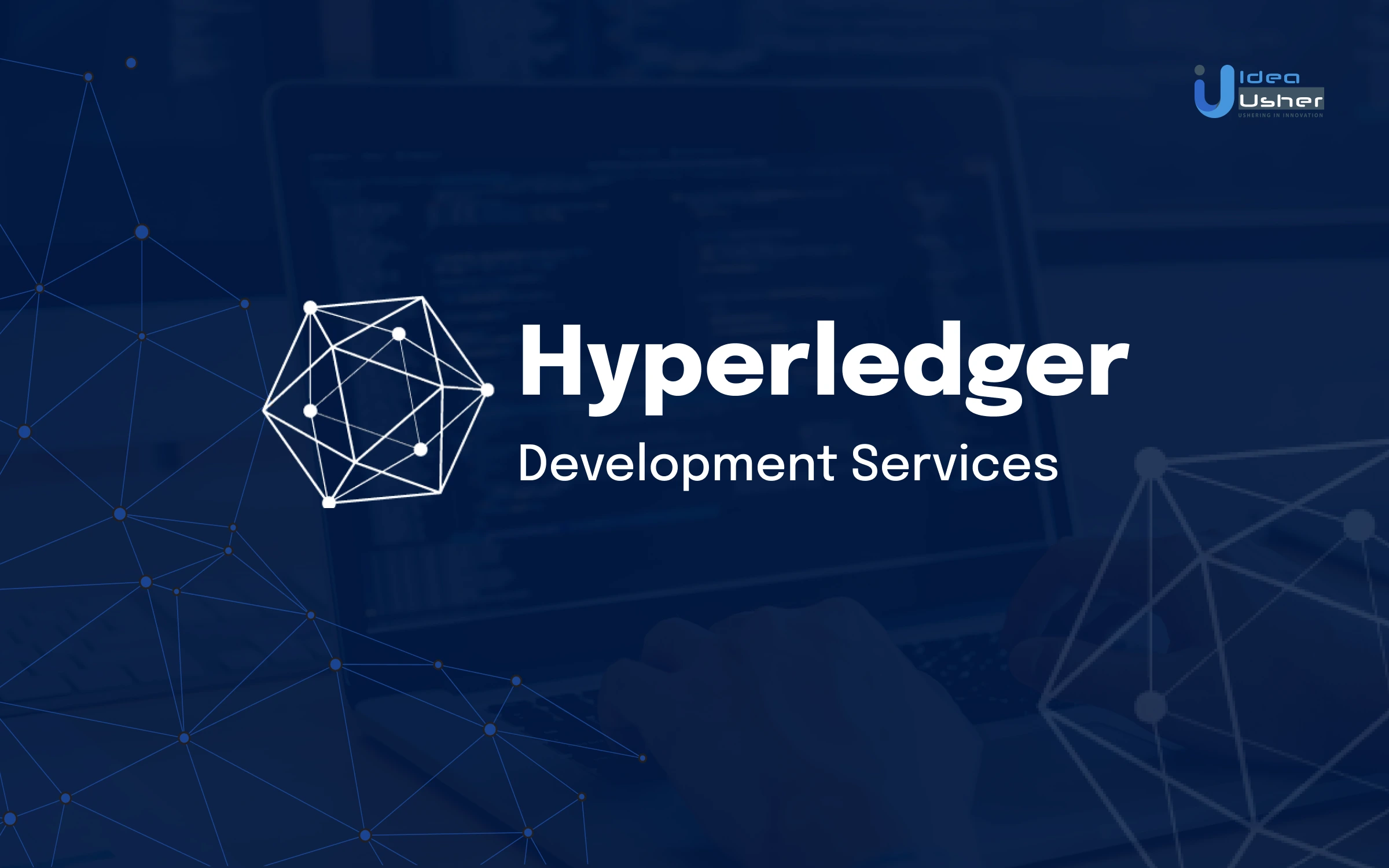Overview: Hyperledger is a free-to-use ledger solution that enables businesses to quickly and efficiently develop blockchain service applications. From designing and building a blockchain network to deploying and managing applications, Hyperledger provides firms with a dedicated suite of tools and resources they need to leverage the power of blockchain.
What is Hyperledger in blockchain?
Developed by the famous non-profit technology consortium Linux Foundation, Hyperledger is an open-source platform for building enterprise-level blockchain applications. It provides a secure, distributed, and permissioned blockchain infrastructure for organizations to develop and deploy distributed ledger networks that can facilitate and track transactions of any kind.
The platform is powered by open-source distributed ledger technology, designed to support secure, reliable, and efficient transactions between multiple participants. Businesses of any size can use it to build and deploy blockchain applications that can help improve efficiency, transparency, and security. It also provides developers with a wide range of tools and features for building and deploying distributed ledger applications. As such, businesses are increasingly turning to Hyperledger to unlock the potential of blockchain technology for their operations.
Understanding Hyperledger’s Underlying Design Philosophy
Consider this example:
John and Mary are two financial institutions with a long-standing mutual legal agreement. As such, they trust each other to record and report transactions between them correctly. They decided to use a distributed ledger to ensure that these transactions were accurately and securely recorded. This ledger can be updated quickly and securely so that both parties can immediately confirm any transaction. The ledger uses a consensus algorithm designed for high levels of trust, allowing the addition of blocks to the chain with shorter confirmation times. This ensures that financial institutions can process their transactions quickly and efficiently without sacrificing security.
In contrast, if two parties have a low level of trust, they may need to use a different consensus algorithm. This algorithm would be more secure but require more time to process the transactions due to the slower confirmation times. This means that the two parties would need to be more patient with the transaction process, but this would mean that their transactions are highly secure.
In either case, distributed ledgers can provide an efficient and secure way to record and verify transactions between parties. Depending on their trust level, the consensus algorithm can be adjusted to meet their specific needs.
With Hyperledger, businesses can find the best combination of these factors to suit their needs. By taking advantage of the full spectrum of use cases offered by Hyperledger, businesses can create a blockchain-based system tailored to their requirements and goals. This way, businesses can rest assured that their processes are optimized to the highest degree, resulting in improved efficiency and performance.
Hyperledger projects strive to be modular, secure, interoperable, cryptocurrency-agnostic and equipped with APIs to accommodate the diverse needs of users.
Modularity
Hyperledger frameworks have reusable components that make it easier to develop distributed ledger solutions that meet specific needs. This modular approach allows developers to experiment and adjust individual components without disrupting the entire system. It enables different developers to work on different modules and share common ones across multiple projects.
High-Security
Distributed ledgers are complex systems that require robust security measures to protect high-value transactions and sensitive data. They must resist persistent attackers while providing a range of features and functions. By ensuring that distributed ledgers are secure and robust, they can become the infrastructure for future business networks.
Interoperability
The future of blockchain technologies lies in the ability of different networks to communicate and exchange data to build robust, interconnected systems. The Hyperledger developers believe that the key to achieving this is creating a high degree of interoperability between networks, so that smart contracts and applications can be easily used across different blockchain networks. This is essential for the continued growth of blockchain technology adoption.
Cryptocurrency-agnostic
Hyperledger projects are entirely independent and not associated with digital currencies, altcoins, cryptocurrencies, or tokens. The foundational goal behind creating the DLT has never been to issue a cryptocurrency but rather to provide blockchain software for businesses. The platform is designed to include the ability to create tokens to manage digital objects, although this is optional for the network to run effectively.
Full-fledged API Compatibility
Hyperledger projects provide comprehensive and user-friendly Application Programming Interfaces (APIs) to easily enable external clients and applications to integrate with the core distributed ledger technology. These APIs foster the growth of a vibrant developer community and facilitate the broader adoption of blockchain and distributed ledger technologies in different domains and applications.
Effective Hyperledger Tools and Frameworks
Hyperledger fosters the advancement of blockchain technologies for business purposes, such as:
- distributed ledger frameworks,
- smart contract engines,
- client libraries,
- graphical interfaces,
- utility libraries, and
- sample applications.
Their totalitarian approach encourages the reuse of fundamental components, accelerates the development of individual components, and encourages compatibility between different projects. Below mentioned are all the tools and frameworks inclusive of the Hyperledge project.
Tools
1. HYPERLEDGER CALIPER
Caliper is a performance-measuring tool designed to evaluate the effectiveness of various blockchain implementations. It provides a comprehensive set of measures, such as resource utilization, transaction latency, and transactions per second, to generate reports that can help organizations identify the blockchain implementation best suited to their needs.
Caliper, although a powerful tool that can be used for in-house benchmarking, does not publish benchmark results. The community can add more performance indicators and benchmark use cases as the project evolves. The success of Hyperledger Caliper depends on its as-per-need utility, according to community members.
2. HYPERLEDGER CELLO
Cello is a toolkit that enables businesses to swiftly adopt blockchain technology. It provides a multi-tenant chain service on various infrastructures, from bare metal to cloud platforms such as AWS and container platforms like Docker Swarm and Kubernetes. This facilitates the efficiency of “Blockchain as a Service (BaaS).” The toolkit also provides a real-time dashboard for users to monitor the status of their blockchain system, view statistics such as events and chaincode performance, as well as manage blockchains and chaincode by creating, configuring, and deleting them.
Built on a microservice architecture, Cello is designed to be flexible and extensible, written primarily in Python and JavaScript. As of now, Cello enables users to primarily deploy and manage Hyperledger Fabric networks, with plans to expand support to other blockchains such as Hyperledger Sawtooth.
3. HYPERLEDGER COMPOSER
Composer is an open-source development toolset designed to make it simpler and faster to create blockchain applications and smart contracts to solve business problems. This toolset can help expedite the process of integrating blockchain applications with existing business systems, allowing users to quickly deploy a blockchain solution in weeks instead of months. Composer allows users to model an existing business network and integrate existing systems and data with blockchain applications. Business networks can contain assets such as goods, services, property, and related transactions and define how transactions interact with assets. Business networks also include the participants who interact with them, and each participant can be associated with a unique identity across multiple business networks.
4. HYPERLEDGER EXPLORER
Explorer is a web-based dashboard that facilitates viewing blockchain information like blocks, nodes, statistics, smart contracts, transactions, and more. The aim of the project is to create a generic, easy-to-install, and maintainable explorer that utilizes the latest technologies and supports popular package managers.
It offers a user-friendly interface for querying and viewing detailed information about specific blocks or transactions. Additionally, Explorer can be integrated with authentication and authorization platforms to provide suitable functions for each user. Currently, Hyperledger Explorer works with the Hyperledger Fabric framework.
5. HYPERLEDGER QUILT
Quilt helps bridge different ledger systems by implementing the Interledger Protocol (ILP) in Java. It is basically an open-source protocol that provides an international framework for account management, enabling transactions to be conducted across multiple ledgers.
Frameworks
1. HYPERLEDGER BURROW
Burrow is a revolutionary blockchain client designed to help users take advantage of the power of permissioned smart contracts. Developed by Monax and accepted into the Hyperledger family in 2017, Burrow provides a secure, deterministic platform to create and execute smart contracts. It allows users to create a custom access control layer using secure native-based permissions, ensuring that only authorized parties can access the data stored within the blockchain. By leveraging the Ethereum Virtual Machine specification, users can trust that their smart contracts will run exactly as they expect. With Hyperledger Burrow, users can trust that their data is secure and their smart contracts will execute properly without any unexpected surprises.
Burrow enables developers to construct sophisticated industrial processes with a strongly deterministic smart contract engine. At the platform’s core is a consensus engine that maintains the networking stack between nodes and orders transactions to be used by the application engine. Additionally, the platform features an Application Blockchain Interface (ABCI) that provides the interface specification for the consensus engine and application engine to connect. Finally, a gateway provides programmatic interfaces for system integrations and user interfaces, allowing for a seamless user experience.
2. HYPERLEDGER FABRIC
Fabric is designed to be a robust, secure, and scalable solution for developing distributed ledger applications. Fabric offers a high degree of flexibility, resiliency, and confidentiality through its modular architecture, enabling solutions to be tailored to a wide range of industry needs. With features such as plug-and-play consensus and membership services, along with container technology to host chain code smart contracts, Fabric can address the complexities of the modern economy.
The blockchain platform offers a versatile, customizable solution for running distributed applications. It works with various consensus protocols and doesn’t require users to write code in a special language or to use a cryptocurrency. Instead, Fabric uses a portable system of membership that can be connected to standard identity management. Its innovative architecture also helps protect against non-determinism, resource exhaustion, and malicious attacks, making Fabric an ideal platform for many applications.
On a Fabric network, groups of participants can also form their own private channels, allowing them to keep their transactions confidential and secure. By creating their own private channels, these competitors can keep their information secure, ensuring that only the parties involved in the channel have access to the ledger.
3. HYPERLEDGER INDY
Trust is essential for any interaction between entities, and the Indy platform provides the foundation for establishing trust between them. By leveraging distributed ledger technology, Indy creates a secure, shared source of truth that enables organizations and individuals to reliably verify each other’s identities, even across administrative domains, applications, and other organizational silos. This means that friends, competitors, and even antagonists can all rely on this single source of truth, allowing them to confidently engage in trusted interactions with one another.
Indy offers users the power of self-sovereignty regarding their digital identities. Through the ledger, every individual can store their identity artifacts, such as public keys, proofs of existence, and more, with distributed ownership. This ensures that only the true owner can change or remove any identity. Furthermore, Indy keeps privacy in mind by default, allowing each user to operate without creating any correlation risks or leaving behind any digital footprints. Finally, users can create verifiable claims that resemble traditional credentials such as birth certificates, driver’s licenses, passports, etc. These can be combined and transformed using zero-knowledge proofs to selectively disclose the data required for any particular context.
4. HYPERLEDGER IROHA
Hyperledger Iroha is a blockchain framework designed to make distributed ledger technology simple and easy to incorporate into infrastructure projects. Developed by Soramitsu in Japan, Iroha was proposed to Hyperledger by Soramitsu, Hitachi, NTT Data, and Colu and joined Fabric and Sawtooth in October 2016. Iroha stands out from other distributed ledger platforms in its focus on providing features that are tailored to the development of applications for end users. Its modern, domain-driven C++ design and simple structure make it an ideal choice for mobile application development and its unique Sumeragi Byzantine Fault-Tolerant consensus algorithm further contributes to its efficiency.
5. HYPERLEDGER SAWTOOTH
Sawtooth is a powerful platform for businesses to create and deploy secure distributed ledgers. It allows them full control over their blockchain applications and makes decisions that best suit their needs. This modular platform ensures that records are kept secure and decentralized, eliminating the need for a central authority or implementation. With Sawtooth, businesses can confidently use smart contracts, knowing that their data is safe and secure.
Sawtooth is a revolutionary blockchain platform that offers advanced features such as dynamic consensus, proof of elapsed time, transaction families, compatibility with Ethereum contracts, parallel transaction execution, and private transactions.
With dynamic consensus, Sawtooth allows consortiums to quickly adapt to changing market demands by simply issuing transactions. This is in contrast to traditional blockchains, which are compiled-time pluggable. Sawtooth also provides scalability with its proof of elapsed time consensus algorithm, which is much more power efficient than proof of work. Furthermore, Sawtooth’s transaction families provide a smart contract abstraction that enables users to write their own smart contract logic. Sawtooth is also compatible with Ethereum contracts, making it an ideal platform for enterprise use.
Moreover, Sawtooth’s parallel transaction execution allows for faster block processing to partially address the performance bottleneck of blockchains compared to traditional databases. Finally, Sawtooth’s private transaction feature allows clusters of nodes to be deployed with separate permissioning, providing privacy and confidentiality among participants. Sawtooth is truly a cutting-edge platform that has the potential to revolutionize blockchain technology.
Predominant Use Cases of Hyperledger
In particular, banking, financial services, healthcare, IT, and supply chain management are the five concrete fields that benefit significantly from implementing blockchain technology.
1. Banking
Banks are vested in ensuring that any loan they offer is provided to someone likely to be a responsible borrower. To accomplish this, they carefully examine the personal information of each individual applicant, such as their date of birth, annual income, and other identifying documents, to ensure they are granting credit to a suitable candidate.
Ultimately, banks use the provided personal information to verify an individual’s creditworthiness. Certain regulations may require banks to disclose a person’s personal data to relevant authorities to prevent money laundering. However, keeping such a vast amount of data can make banks a vulnerable target for cybercriminals.
Getting a loan is also an arduous process for borrowers, making it difficult to compare rates. The application is intrusive, and each new application puts the applicant’s personal information at risk of being misused.
Hyperledger Indy can help in this case as a revolutionary identity solution. With Indy, applicants can provide the necessary information to lenders in a secure, reliable, and compliant manner, allowing them to make informed decisions confidently. Rather than providing potentially sensitive personal data, applicants can generate zero-knowledge proofs that demonstrate they meet the criteria for loan eligibility, such as being over 21, having sufficient income, possessing a valid government ID number, and having a good credit rating. This ledger-based identity system establishes a reliable source of truth, which benefits every party involved. Applicants can give informed consent and have it documented, while lenders conform to regulations and have an immutable audit trail. The overall market can then operate more efficiently, with banks providing loans with confidence and applicants protecting their personal data.
Additionally, employing Hyperledger Burrow and Fabric together aids in creating a better secure, reliable, and comprehensive loan application system. The loan application can be converted into a smart contract and attached to a robust and self-sovereign identity. Furthermore, a membership system can be set up to link to the identity attached to the loan application.
2. Financial Services (FinTech)
The growing demand for privacy, confidentiality, and accountability in the financial services sector is driving the adoption of permissioned and private blockchains. These solutions are essential for meeting the compliance guidelines such as “Anti-Money Laundering” and “Know Your Customer,” which necessitate the ability to verify a customer’s legal identity and grant clearance for transactions.
With the vast amounts of data and transactions, consortium blockchains are quickly becoming an attractive option in the financial services industry. In particular, blockchain technology can be applied to post-trade processing in capital markets to create a more efficient and cost-effective system.

Post-trade processing involves validating and confirming the transaction, matching the trade instructions and confirmations, legally fulfilling the contractual obligations, adjusting the positions held with custodians, and satisfying reporting requirements for regulatory and internal risk. The process is necessary to ensure that the trade is successfully completed, all parties are notified of the transaction, and any market and credit risks are managed.
These substantiate a complex and fragmented workflow that spans multiple departments and entities. The process includes brokers, central security depositories, clearing houses, exchanges, and settlement agents, each with its own individual interfaces, processes, and reconciliations.
Blockchain technology can dramatically increase the efficiency of post-trade processing. By leveraging the distributed ledger system, both parties can insert and verify transaction details in the same place, eliminating the need for costly and time-consuming reconciliation. Additionally, all data is stored on the blockchain, making it accessible on a need-to-know basis and streamlining regulatory and trade reporting. This immutable, irrefutable system enables the network to act as a reliable third party. Aiding the process, Hyperledger Fabric‘s channels can enable the deployment of entirely disjoint networks with separate endorser sets and ordering nodes. This helps limit data replication to only permissioned parties while maintaining the blockchain’s data integrity and non-repudiation of transactions without compromising data security. This segmentation can also support multiple jurisdictions and regulatory regimes. Sawtooth‘s transaction families can also provide a secure way to support post-trade activities. At the same time, Indy‘s unlinkable verifiable claims can be used to report outstanding risk on a shared ledger without compromising privacy, allowing regulatory bodies to take a holistic view of the market and help prevent potential market crashes and major defaults. Lastly, Fabric and Indy put participants in control of their network identities and any attributes they choose to disclose, further strengthening privacy.
3. Healthcare
The medical field is plagued by a long and tedious process known as credentialing. Hospitals must ensure that the physicians they hire are qualified and reliable, and the process of doing so is a major hassle for both the applicant and the hospital. Blockchain technology offers a potential solution that could make credentialing much easier.
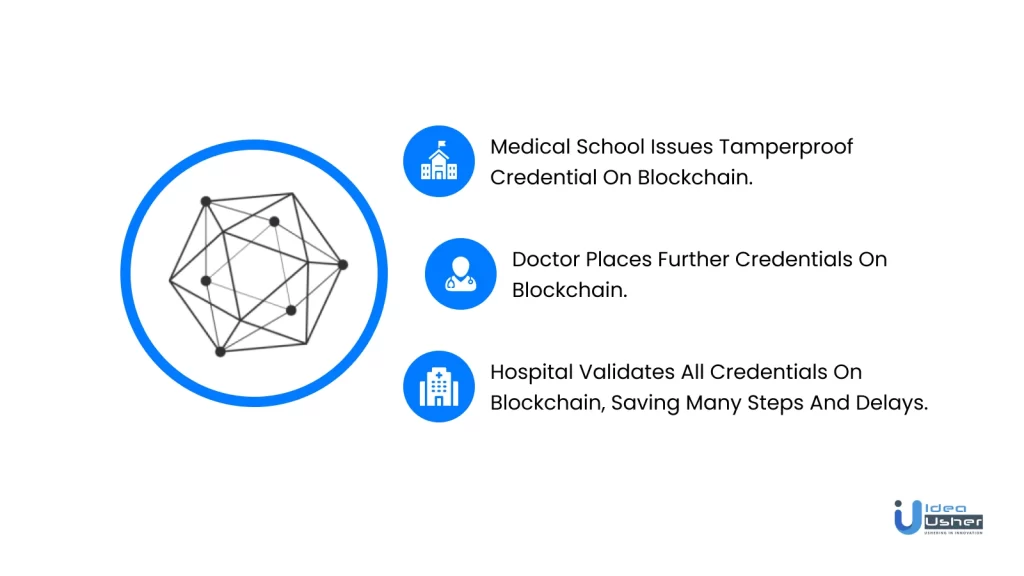
Blockchain-facilitated credentialing would include thousands of participants, hospitals, doctors, and educational sources, all connected together. Public information, like state medical licensing, would be stored directly on the chain, while private information, like peer reviews, would remain off the chain to ensure the secure storage of keys and to allow users to remove data without changing it.
Indy provides an off-the-shelf solution for the pairwise exchange of credentials, as defined by the W3C standard. This allows a physician to request and receive proof of graduation from their medical school, which is stored on the physician’s edge device, not the ledger. The physician can then selectively disclose the data points required by any hospital while protecting their privacy with zero knowledge proof, saving time and effort. This implementation of verifiable credentials safeguards privacy prevents data correlation and keeps personal data off the ledger.
4. IT
One of the most exciting applications of Blockchain is self-sovereign identity – which grants people control of the data that constitutes their identity. This has the potential to revolutionize enterprise IT, as individuals will be able to securely manage and share their identity data, free from the control of third-party organizations. Indy is an advanced identity system that takes traditional identity systems such as 2FA, IDPs, LDAP, and OAuth to the next level. Unlike traditional systems, Indy identities are shared, not siloed and federated. This means that an individual’s identity is stored on a distributed ledger, making it portable and accessible across multiple systems. By having control over their identity and data, individuals can simply show up in any system that supports Indy identities and use them without creating multiple identities. Individuals also have complete control over who they allow accessing their data.

Indy offers a more practical and cost-effective solution for managing identities through an enterprise blockchain. Unlike solutions like Blockstack and Uport which rely on proof-of-work ecosystems such as Bitcoin and Ethereum, Indy does not require high transaction fees. This removes the cost barrier and allows users to adopt Indy without worrying about additional expenses. Additionally, Indy is flexible and can be scaled to fit any context, making it perfect for a less-than-fully-global context. This makes Indy a great identity management solution for enterprises.
5. Supply Chain
Let’s consider the case of the fishing industry.
The global fishing industry is worth an incredible $70 billion, but it is plagued by a number of issues. It is estimated that a fifth of all fish caught is done so illegally, and only a small number of those are inspected. A recent study done through DNA testing revealed that sellers mislabeled a third of all fish. In a detailed sampling from 674 outlets across the US, 87% of snapper and 59% of tuna were mislabeled, and 95% of sushi restaurants were serving mislabeled fish. The consequences of this are serious—it puts consumers’ health at risk, affects vulnerable fish stocks, deprives nations of taxes, and undermines the trust in the industry.
Traceability and provenance of seafood is a complex challenge, especially given the intricate and multi-layered supply chain from ocean to table. Despite the challenges, a shared platform for traceability could be a game changer. Organizations like FishWise have identified the obstacles, such as lack of global authority and paper-based processes that make it difficult to track seafood. But with the help of blockchain technology, tracing our seafood could become much easier. Through the use of a shared platform for traceability, it is possible to ensure the accuracy of seafood labeling, thus identifying and preventing illegal fishing activities. By tracking each supply chain step, we could take a significant stride toward protecting our oceans and their inhabitants.

Hyperledger Sawtooth can help in this case. By attaching sensors to the fish when caught, the distributed ledger can capture data such as location, temperature, and humidity. This data can be stored in the ledger along with other events, such as ownership changes and storage temperature range, that occur during the processing and transport of the fish. With the help of advanced communications and IoT sensors, the traceability prototype shall allow regulators and scientists to analyze the entire process of harvesting and consuming the fish while providing an efficient means of compliance. By utilizing Sawtooth’s lightweight, decentralized consensus protocol (proof of elapsed time or PoET), the prototype can scale to a large, diverse, distributed ecosystem and provide an accurate, secure record of the fish’s journey.
The Hyperledger Development Process (Made Easy!)
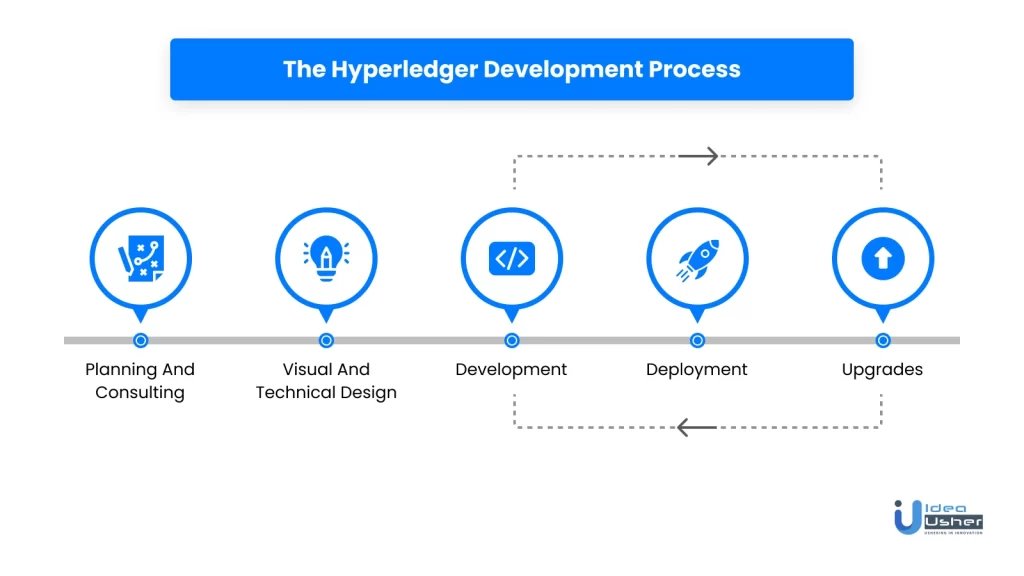
1. Planning and Consulting
Our team of experienced blockchain consultants and developers conducts a feasibility assessment to evaluate the viability of implementing a Blockchain application. We benchmark the current solution (app, software, or platform) to the business goals at every step, determining if this technology could be improved efficiency and efficacy. This assessment allows us to understand better how blockchain technology (hyperledger specifically) could be applied to the existing system and identify any potential challenges that need to be addressed. In this way, we develop a clear plan of action to ensure the successful implementation of the necessary tool/framework technology stack.
2. Visual and Technical Design
The visual and technical design methodology of the Hyperledger development process is based on a modular approach that divides the development process into separate components, allowing each component to be developed, tested, and deployed independently.
This visual approach includes using various tools for diagramming, wireframing, and U/UX to create visual representations of the application’s architecture and components and overall designing of the software’s usability aesthetics. The use of visual tools can help teams learn the application’s overall architecture and workflow, spot potential problems, and identify areas for a redesign.
The technical design of the development process is based on a set of modular components that can be combined to create a complete blockchain application. These components include smart contracts, consensus algorithms, and data stores.
3. Development
Front-end development within the ecosystem is typically done using JavaScript and the React framework. React allows developers to create user interfaces (UI) for their applications quickly and effectively. For instance, a developer could use React to create an interface for their blockchain application that allows users to manage assets, transfer funds, and view transaction history. Sometimes for the front end, businesses may also require creating APIs to allow other applications to interact with them. These APIs can query information from the ledger, submit transactions, and access other data stored on the ledger.
For backend development, any of the combinations of the predefined hyperledger tools and frameworks, aided by additional code and support through Node.js, Python, and express.js, can be used.
4. Deployment
Once development is done, the app can be easily deployed using any container technology (like Docker) or containment orchestration platform (Kubernetes). It only will require installing the engine or cluster on the target device, launching the container/repository, configuring the blockchain, installing the chain code, and commencing the network with the app running on it.
5. Upgrading and Maintenance
Upgrading and maintaining a Hyperledger app requires first identifying any changes that need to be made to the existing codebase. This could include bug fixes, new features, or other changes. Once the changes have been identified, the code must be tested to ensure it works as intended. This can be done using various tools, such as unit tests, integration tests, and end-to-end tests. After the code is tested, it is again deployed to a test environment to ensure everything works as expected. Finally, the updated code is deployed to a production environment/the app itself.
Essential Tech-Stack for Hyperledger Development
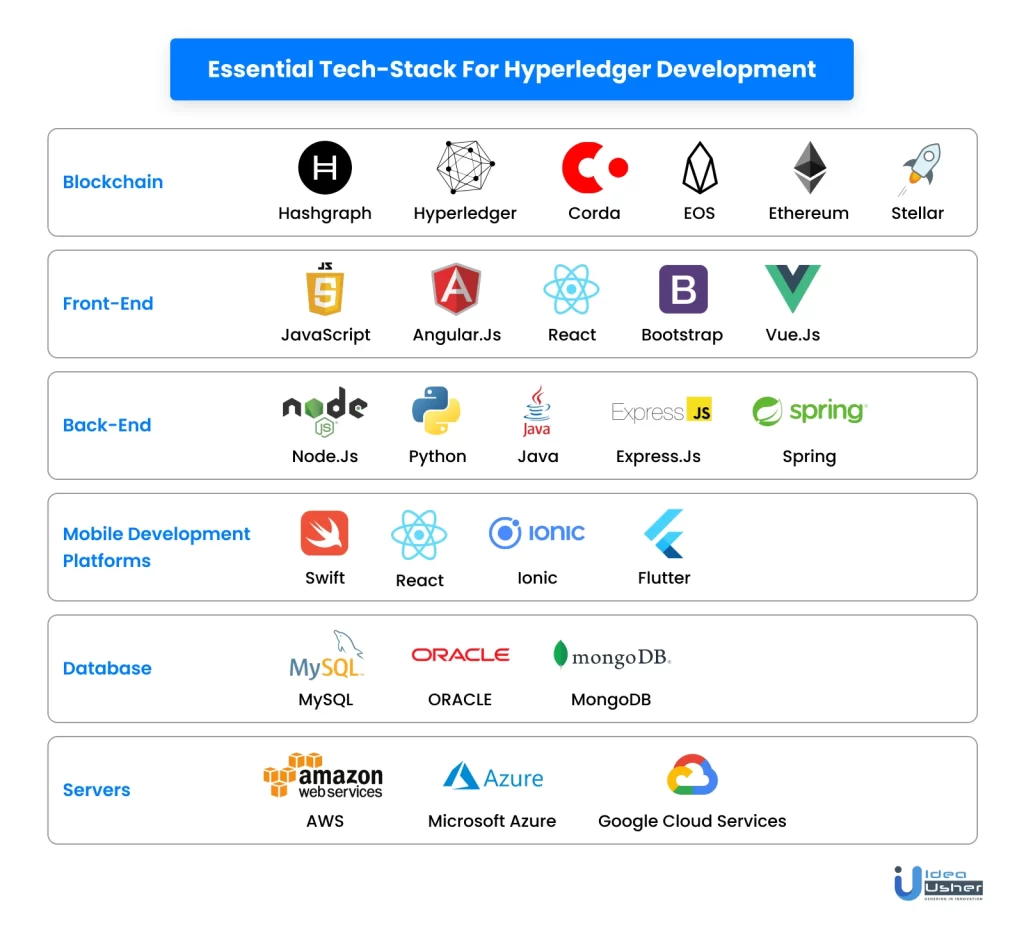
For Hyperledger development, developers can utilize the platform’s toolkit and other technological solutions and services for increased efficiency. At Idea Usher, our developers are equipped with a deep understanding of various DLTs, databases, and servers, allowing us to provide our clients with the highest quality hyperledger development services.
Blockchain/DLTs:
Hashgraph, Hyperledger, Corda, EOS, Ethereum, Stellar
Front-end:
JavaScript, Angular.js, React, Bootstrap, Vue.js
Back-end:
Node.js, Python, Java, Express.js, Spring
Mobile Development Platforms:
Swift, React, Ionic, Flutter
Database:
MySQL, ORACLE, MongoDB
Servers:
AWS, Microsoft Azure, Google Cloud Services
Benefits and Possibilities
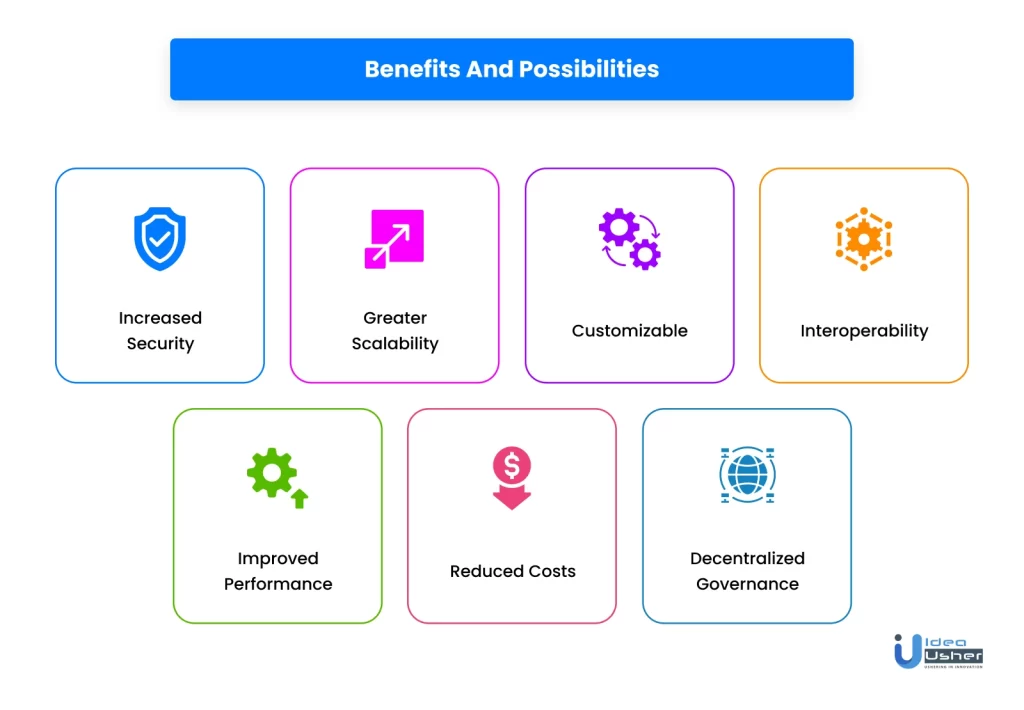
The potential of hyperledger development is seemingly limitless. It has the potential to revolutionize the way businesses and governments interact and transact with one another. In the near future, it could become a standard for how organizations manage and share data, creating a more secure, transparent, and efficient data-driven world.
1. Increased Security
It is a permissioned blockchain that provides an added layer of security that helps prevent malicious activities and unauthorized access.
2. Greater Scalability
Hyperledger can handle high-volume transactions more quickly and efficiently than traditional blockchains, improving the scalability of applications built on the platform.
3. Customizable
Hyperledger is highly customizable, so developers can tailor the platform to their needs. This gives users the flexibility to create custom applications.
4. Interoperability
Hyperledger’s DLT can facilitate interoperability between different networks, allowing organizations to easily exchange information and data.
5. Improved Performance
Hyperledger performs better than other blockchains by utilizing parallel processing. This results in faster transaction speeds and improved user experience.
6. Reduced Costs
Hyperledger eliminates the need for third-party intermediaries, reducing transaction costs, and making the platform an attractive option for businesses looking to save money.
7. Decentralized Governance
Hyperledger could be used to create decentralized autonomous organizations (DAOs), organizations governed by a set of rules encoded into a blockchain. These organizations could operate without human involvement, creating more efficient and secure systems.
Why Choose Us for Your Hyperledger Development Services
With a plethora of frameworks, tools, and services, Hyperledger can help you reach your goals and make the most of your investments. There is a broad scope of industrial implementation, and the utilities can be modified to befit your business’s needs. But still, you need a reputed development partner that can cater to your necessities. At Idea Usher, we understand that technology is the cornerstone of success and growth in today’s world. We strive to provide our clients with the best solutions to ensure their businesses get the most out of their technology investments. Our expert developers can build custom, feature-rich applications to help automate and scale your business’s services.
Get in touch with us now!
Build Better Solutions With Idea Usher
Professionals
Projects
Contact Idea Usher at [email protected]
Or reach out at: (+1)732 962 4560, (+91)859 140 7140
FAQs
Q. What is Hyperledger development?
A. Hyperledger development involves creating and deploying applications using Hyperledger, an open-source collaborative effort designed to advance cross-industry blockchain technologies. Development may involve devising distributed ledger solutions for trade finance, healthcare, supply chain, and other industry-specific applications. The platform’s integrative suit gives developers access to many tools and frameworks for building, deploying, and maintaining distributed ledger applications.
Q. What is the difference between blockchain and Hyperledger?
A. Blockchain is a distributed, digital ledger technology that can store data securely and transparently. It is a decentralized database that maintains a continuously growing list of records, called blocks, which are secured using cryptography. Blockchain is a public, permissionless system that allows anyone to join and transact.
Hyperledger, on the other hand, is an open-source collaborative effort created to advance cross-industry blockchain technologies. It is a platform for distributed ledger solutions underpinned by a modular architecture that enables organizations to build applications, platforms, and hardware systems to support their business transactions. Unlike blockchain, it is a private, permissioned network that requires organizations to join and be approved before participating in the network.
Q. Which language is used in Hyperledger?
A. Hyperledger is based on a modular architecture and supports many programming languages. The primary languages used in Hyperledger are Go, JavaScript, and Java. Go is a language created by Google for its own internal use and is used for distributed ledger technology, such as Hyperledger Fabric and Hyperledger Sawtooth. JavaScript is used for Hyperledger Composer, a tool for developing blockchain applications, and Java is used for Hyperledger Iroha and Hyperledger Indy. Other languages that can be used in Hyperledger include Python, Scala, and Rust.
Q. What are the tools of Hyperledger?
A. The Hyperledger tools include Caliper for blockchain benchmarking, Composer for modeling and building blockchain applications, and Explorer for exploring blockchain networks. There also exists Cello for deploying and managing blockchain networks and Quilt for interoperability between distributed ledger technologies.
Q. What are the frameworks of Hyperledger?
A. The Hyperledger frameworks include Fabric, Sawtooth, Iroha, Indy, Burrow, and Besu. Fabric is mainly used for creating applications or solutions with a modular architecture, and Sawtooth is used for creating distributed ledgers. Iroha is a simplified version of Fabric. Indy is a distributed ledger for digital identities, Burrow provides a permissioned blockchain, and Besu is an Ethereum client.
